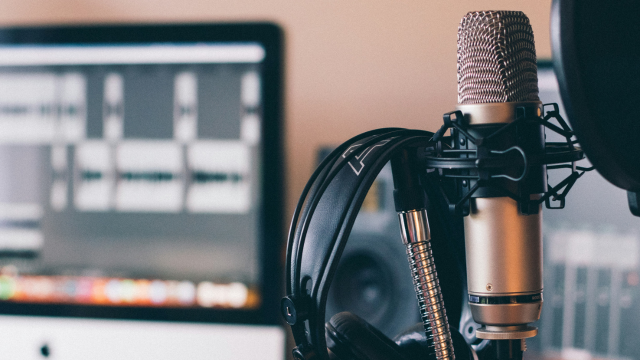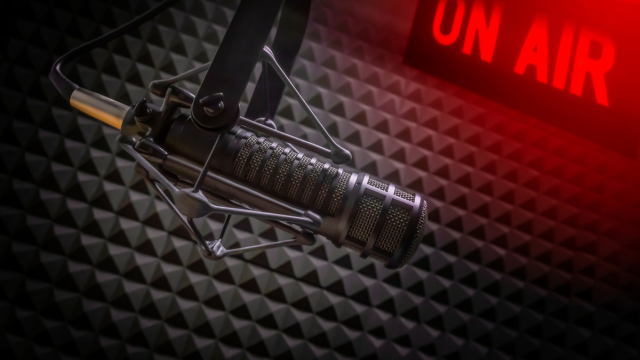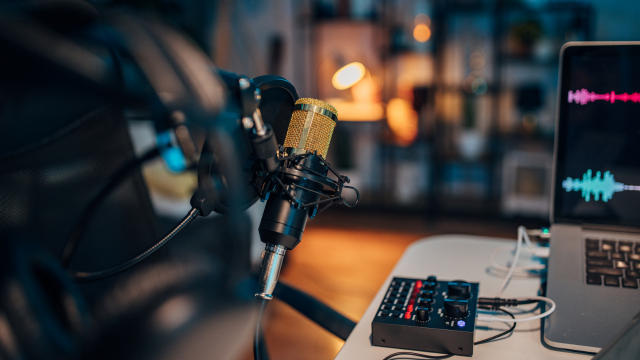When starting a podcast, you must have all the right tools to ensure quality output. When it comes to software, various options cover a range of tasks during the production and post-production of podcasts.
The Best Podcast Software
In this article, we look at the best podcast software you can use to help you produce the best podcasts for your brand.
Recording and Editing
Recording and editing software is essential for everyone to record the audio for the podcast and then edit the clips to create a polished episode, which might include adverts, intros, and exits. Here are three recommended options.
Descript
Descript is a premium podcast recording and editing software package. There are four different pricing points, including one free option that allows one recording a month but is watermarked.
Other account types allow for more recordings per month, and even other features such as audio enhancements and access to AI tools.
Riverside
Riverside is one of the most well-known audio recording software options. They use local recording systems to ensure quality remains the same, even if there are poor connections.
So, for those conducting interviews, the audio and video files don’t lose quality when someone loses connection for a moment.
There are also lots of great tools that can help podcast producers deliver outstanding episodes, such as AI-generated podcast notes. Riverside states that their software can help speed up production by 65%.
Adobe Audition
Adobe Audition is a software option from the Adobe software family. Able to help potential podcasters record and edit their podcasts easily, this option is one of the more expensive options on the list and can be more challenging to learn.
To help those new to the software there are tutorials and an online community that can help. However, for those who want to do video podcasts, you might need to have additional software to enable you to record the participants in the podcast and align the audience.
Hosting Platforms
Within hosting, there are going to be very few people who will hear your podcast, and this will lessen your returns. Having a podcast directly on your website will not be effective either. Audio files slow down a website, reducing traffic and listeners to your website. So, a hosting platform is essential.
Libsyn (Liberated Syndication)
Libsyn allows you to upload your podcasts to their hosting platform to be distributed across all podcast players, such as Google, Apple, and Spotify. Their plans start from $7 per month, with varying allowances on the time/memory they allow to be uploaded.
However, each plan allows for at least a simple promotion of the podcast and monetization.
Captivate FM
Captivate FM allows you to upload as many episodes as you would like per month. You can also see the statistics for how many people are listening and where they are. There is also extensive distribution across the various podcast streamers.
Where Captivate puts limits on their plans is the number of downloads you can have. With just 30,000 per month on their personal plan.
Distribution Platforms
Distribution platforms are the main ways listeners will subscribe to and download your podcast for listening. There are several available, with the three main ones being:
Apple Podcasts
There aren’t many who don’t know about Apple Podcasts. They have an extensive library and anyone with an Apple Device or account can access this and download podcasts.
Spotify
One of the biggest distributors, Spotify does well to help podcasters get heard. They have their monetization programs, and you can upload directly to them. However, if you do this with all the distribution platforms, it can eat into your time.
Google Podcasts
Another popular way for audiences to find and engage with podcasts is Google. Google has the benefit that most people have a Google account, so there are few limitations on access to content.
Analytics and Monetization
If you want to make a return on your podcast, then you’re going to have to monetize at some point. To get the most out of monetization, analytics are critical. You need to know how many people are listening and other critical KPIs so you can make informed decisions.
Chartable
An advanced suite of statistics, Chartable has numerous price points suitable for podcasters of various sizes. With ways to track not just how many people are listening to your podcast and where they’re downloading the podcast from, but also who is listening to the advert, where they heard it, and who took action on it.
There is a free option for those just starting, but there are limits on what you can do on the free plan.
AdvertiseCast
Allows podcasters to monetize their shows. Listing your podcast is relatively simple, and advertisers can then select your show to advertise on with sixty-second adverts. You can be paid directly with AdvertiseCast. The service to list your podcast is free, but all revenue has a 30% commission.
Remote Recording and Interviews
One of the best ways to get engagement on a podcast is to complete interviews. With the latest technology, you don’t need to do the interviews in person either, you can do them remotely with software.
Riverside FM
Riverside FM is one of the best remote recording software options. It utilizes local recording to ensure quality control. And with lots of AI options to help with productivity as well you can save a lot of time using Riverside FM.
While many options allow for remote interviews, such as Zoom and Google Hangouts, the free options can often result in poor-quality video output and sometimes dropouts.
Transcription Services
Transcription services are essential to ensuring that audiences have an option to read the podcast. They can also be good to reference later when you want to write the next script, use the interviews to create a blog post, or want to find a statistic mentioned in a previous episode. There are manual options for this, but these can be expensive.
Descript
Descript has numerous price points that allow for the recording and editing of podcasts. Those who use the Pro plan can also benefit from having AI-generated transcripts of their podcasts that they can use for distribution.
Another benefit of the Pro plan is that AI can remove filler words like ‘uh’, ‘um’, and others. These words can lower the quality of the content and reduce audience engagement.
Therefore, the Pro plan can enhance the quality of the content.
Rev.com
AI-generated transcriptions can be a good way to save money and time, but that doesn’t mean they’re always accurate. Rev.com offers an affordable option for transcription done by humans. The charges are based on the number of minutes your podcast is on for and can be translated into English and other languages.
Website and RSS Feed Management:
Google and other search engines aren’t able to index audio, yet. Therefore, you need a website to ensure listeners can find you. There are numerous ways to get a website, if you don’t already have one, to manage the RSS feed of your podcast, as well as being used to bring audiences to you.
WordPress
Many podcasters use WordPress for creating a website and managing their RSS feed. WordPress is simple to use and can be customized for the specific needs of the website owner. There are also two options WordPress.com and WordPress.org.
With numerous themes and design tools, it doesn’t need a developer to help you get a website going. You can automate many marketing elements, such as publication of social media posts and more.
Captivate FM
Those who use Captivate FM can gain access to a free WordPress website. This can be edited and adjusted so you can manage your RSS feed, as well as use pages to improve SEO to get found online.
With hosting covered, it is one less thing that you need to worry about when you are trying to get your podcast going.
FAQs: Podcast Software: What Do You Need?
What software do I need for a podcast?
You need different pieces of software for a high-quality podcast. From editing to monetization, select a balance of requirements and budget to get the best performance.
What is the best software to record a podcast?
There are numerous options to record a podcast. You have to select an option best suited for your type of podcast.
What podcast software does Joe Rogan use?
Joe Rogan uses some of the best podcast software to produce his content. To record and edit, he uses Adobe Audition software.
Final Word: Podcast Software: What Do You Need?
The best Podcast software isn’t easy to identify. It all depends on your specific needs and goals. And the best option for you isn’t always expensive – it can sometimes be free.
However, when you work with a podcast consultancy, they can help you choose the best equipment and software to ensure your episodes are of the highest quality.
Produce Your Podcast is a premier podcast consulting, production & marketing agency. Our team of experts provides comprehensive, full-service quality solutions for B2B clients to incorporate podcasting into their overall marketing strategy. If you’re looking for a reliable partner to help launch or grow your business-branded podcast and boost your sales and marketing goals, we’re here to help.
Click here to schedule a conversation with our team today. Let’s work together to create a high-quality podcast that takes your business to new heights!





